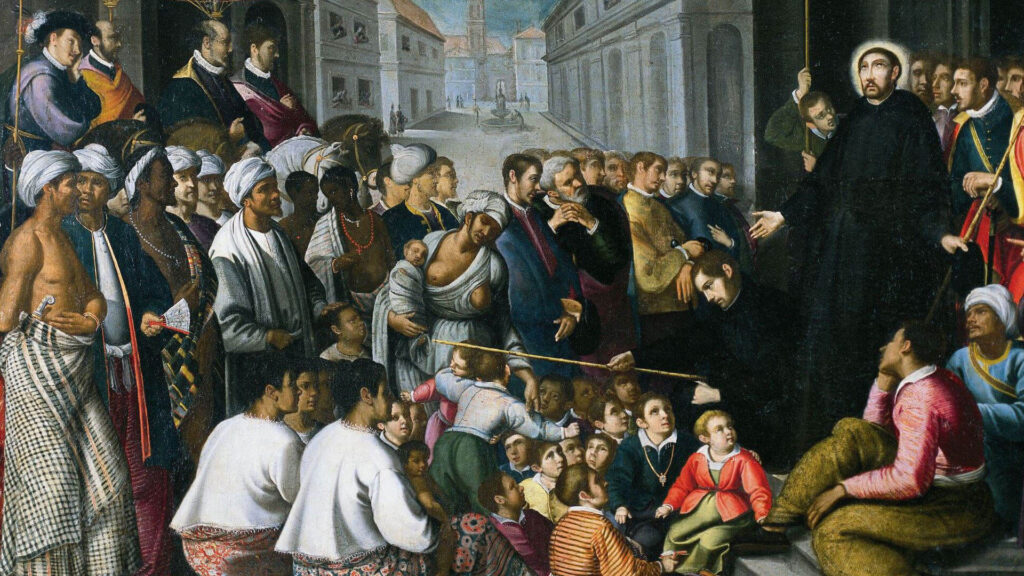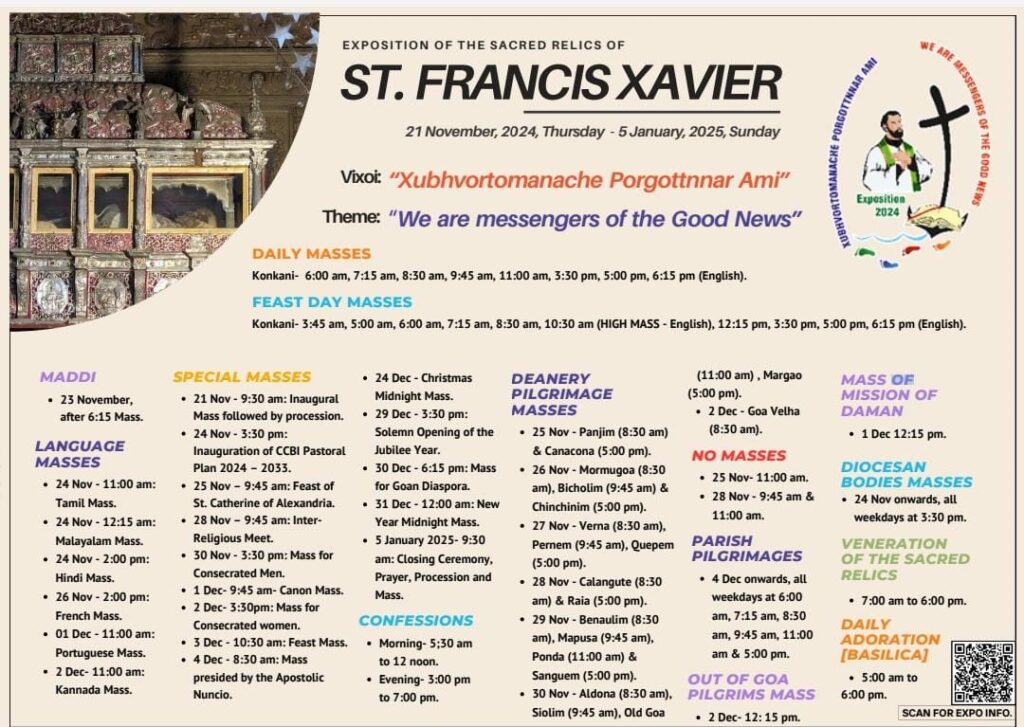
On November 21, 2024, the exhibition of the relics of St. Francis Xavier that takes place every ten years was opened at Old Goa. From November 21 to January 5, 2025 the relics will be displayed on a special podium, for the veneration of pilgrims. The body of Saint Francis lies in a silver urn which is normally kept in the Basilica of Bom Jesus in Old Goa. On December 1, 2024, a mass in Portuguese will be held at 11 am in the Cathedral of Old Goa in honor of St. Francis Xavier.
About Saint Francis Xavier
Francisco Xavier was born near Pamplona, Spain, on April 7, 1506, fifth son of D. Juan de Jasso y Atondo, Lord of Xavier and idocin, and of Dona Maria de Azpilcueta and Xavier. At the age of 19 he goes to Paris, to study Literature at the College of Santa Barbara. He graduates in Philosophy and Theology from the Sorbonne, obtaining the academic degree of “Magister Artium” in 1530, ready for an academic career.
However, he meets Ignatius of Loyola, who would become the founder of the Society of Jesus. He becomes his friend and follower and over time enters the true process of conversion.
On August 15, 1534, in the Montmartre Chapel, he takes the vows of poverty and perpetual chastity and receives Holy Orders in Venice on June 24, 1537, leaving for Rome where he makes himself available to the Pope for the service of the Church.
On March 15, 1540, he leaves Rome for Lisbon, sent by Pope Paul III. It is Rome’s response to the vehement appeals of the King of Portugal, D. João III, who is concerned with the evangelization of India and the dissemination of the Faith in the East.
He was the first Jesuit who left Lisbon for the missions in the Indies, on April 7, 1541. Before his departure, King D. João III handed him the Papal Brief naming him Apostolic Nuncio in the Parts of India, with broad powers to establish and maintain the Faith throughout the East. The trip from Lisbon to Goa lasted around 13 months; a tiring journey due to lack of food, intense heat and storms. He arrived in Goa on May 6, 1542, choosing the city hospital as his home. He soon offered his services to D. João de Albuquerque.
In October 1542 he left for South India to evangelize the fishermen and in October 1543 he returned to Goa. After canonically founding the Society of Jesus, Father Francisco Xavier is appointed Superior of the entire East India Mission, from the Cape of Good Hope to China. He returned to South India and then visited Malacca (Malaysia), the Moluccas (Indonesia), and Ceylon (Sri Lanka).
Between the years 1545 and 1547, Francis manages to advance to other regions. He teaches, baptizes, transmits the principles of the Catholic faith and conciliates conflicting princes.
Death in Shang Chuan
Sailing, via Cochin and Malacca and through the China seas, he arrives in Kagoshima on the south coast of Japan on August 15, 1549 in order to take the Gospel to the land of the “rising Sun”. Although he knew about the death penalty for anyone administering the sacrament of Baptism, he submitted himself to learning the language and its customs in order to proclaim Christ.
Back in Cochin he sends letters to King João III. requesting missionary reinforcements. Attempting to missionize in China, he heads there aboard the ship Santa Cruz. In Singapore he writes again to D. João III. In September 1552, he disembarks on Shang Chuan Island, close to Macau, in China, where he tries to embark for the city of Guangzhou near Hong Kong, but is struck by a strong fever and fatigue, becoming seriously ill. Suffering vertigo and convulsions, overcome by fever, full of deprivation, he dies alone and poor on the night of December 2 to 3, 1552. He had traveled thousands of kilometers, crossed the Indian and Pacific seas several times, visited more than dozens of kingdoms, founded Churches, reorganized missions.
An example of humility and Christian solidarity, of love for others and of evangelical poverty, he is venerated by thousands of people of all social conditions, of all ages, of all ethnicities. The fame of Santo, the “Saint of Goa”, had reached everywhere, his virtues were exalted.
This great missionary saint entered Heaven at the age of 46 and after ten years of apostolate. His thoughts can be summarized in a prayer that they say he always prayed: “Lord, I love you, not because you can give me heaven or condemn me to hell, but because you are my God! I love you because you are you”!
On February 17, 1553, his body was removed and taken to Malacca and from there to Old Goa (former and first capital of the Portuguese State of India), where he arrived on March 16, 1554. Receiving him, in an impressive manifestation of Faith, there were the Viceroy, the Clergy, the Nobility and the immense People, who still know him today as Gõycho Saib (Lord of Goa in the Konkanim language, the vernacular of Goa).

The devotion he already enjoyed during his life time would grow extraordinarily after his death. His miracles became known. On October 25, 1605, Francis Xavier was beatified by Paul V. Gregory XV canonized him on March 12, 1622. On February 24, 1748, Benedict XIV proclaimed him Patron Saint of the East. In 1904 Pius X placed the Sacred Congregation for the Propagation of the Faith under his protection. In 1927, Pius XI constituted him, with Saint Teresa of the Child Jesus, protector of all missionary works.
His body rests in a rich silver urn, in the Basilica of Bom Jesus, in Old Goa. Thousands of pilgrims, believers and even non-believers, head there, venerating the “Good Man”, the tireless apostle.
The Church celebrates his feast every year on December 3rd.




